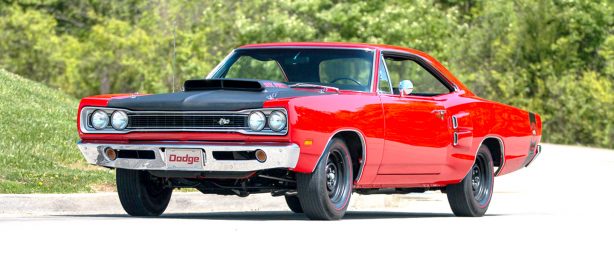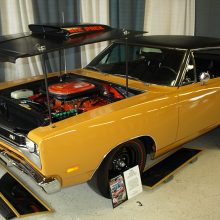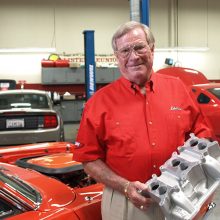They Are Not Race Cars
The 1969-1/2 Six Pack Super Bee
Dodge’s seventh Package Car entered the world with a slight identity crisis. This excerpt from a letter from Chrysler Performance Executive Tom Hoover (the “father of the HEMI®”) to NHRA Technical Director Farmer Dismuke sums things up. Dated April 24, 1969, Hoover wrote: “We feel we should again explain the philosophy behind these cars (the Dodge 440 Six Pack Super Bee and Plymouth 440 6BBL Road Runner – ed.). They are NOT race cars. They were designed for the youth enthusiast market. Their purpose is to help maintain the Roadrunner / Super Bee sales momentum. The package exhibits good all-around performance – braking, handling, acceleration – at a reasonable price with a lot of individual identity.”
Hoover was writing about the legendary 440 Six Pack Super Bee (and its Plymouth 6BBL Road Runner cousin). Though Hoover’s claim that the Six Pack wasn’t directly intended for sanctioned drag race competition is honest, with its standard-issue 4.10:1 rear axle ratio, drag-inspired staggered rear leaf springs, lift-off fiberglass hood and triple Holley 2-barrel carburetors, straight line acceleration was its featured skillset. Plus, we’ve never heard of any serious attempt to road race or rally race a somewhat nose-heavy Six Pack. The drag strip (legal and after hours) was its natural habitat.
Launched on February 2, 1969, as a mid-year offering, the Six Pack Super Bee was essentially a basic 383 Super Bee with a 440 heart transplant, fine tuning for better acceleration and plenty of brash, street racer image. The 383 Super Bee’s big 11-inch drum brakes, thick torsion bars and front anti-roll bar were unchanged. Beyond the new 440 Six Pack engine, the key change in the recipe was the rear suspension. In place of the 383’s matched 5-leaf heavy-duty rear leaf springs, the Six Pack used Street HEMI springs which had six leaves on the driver side and 5 leaves, plus 2 half leaves on the passenger side.
The unequal (R/L) leaf configuration was intended to counter the effect of torque reaction and pinion rise to keep the right rear tire from unloading against engine rotation. The two extra half-leaves on the passenger side acted only on the forward half of the spring to stiffen it like a bolt-on traction arm. This was straight-line stuff and was an outgrowth of research and testing conducted by Dodge’s factory drag race team, The Ramchargers, during the Race HEMI era.
The other major drag race-inspired item added to the Six Pack Super Bee was a Dana 60 rear axle equipped with 4.10:1 gears. This axle was installed in every Six Pack, including automatic transmission cars. Previously in 1966-’68, the massive Dana 60, with its indestructible 9-3/4-inch ring gear, was used only in 4-speed Street HEMI applications, and never with a ratio lower (higher numeric) than 3.54:1. So by upping the mechanical advantage with steeper 4.10:1 gears, stronger acceleration resulted – with a sacrifice in top speed from about 130 to 118 mph (versus a Super Bee with more common 3.23:1 or 3:55:1 gears). Ask any drag racer and they’ll tell you to “build the car from the back to the front,” starting with a good rear suspension that assures good traction. After all, big power is useless if the rear suspension hops, shudders and causes tire spin.
With its drag-optimized rear suspension, the Six Pack’s other advance was the addition of triple Holley 2300 series 2-barrel carburetors to the basic 440 Magnum big block V8 already used in Charger and Coronet R/T models. The added breathing capacity boosted output from 375 hp / 480 ft-lb to 390 hp / 490 lb.-ft. while a standard dual point distributor (previously only used on 4-speed 440 Magnums in the 1967-’68 period) and special low friction hydraulic valve lifters played on the same 440 Magnum-spec. camshaft. Two transmission choices were offered, the 727 TorqueFlite automatic and Chrysler’s 18-spline A833 HEMI 4-speed manual (less torque-rich 383 Super Bees got a lighter duty 23-spline version of the A833 4-speed).
Beyond the drag-inspired rear suspension and deep breathing induction upgrades, Chrysler Corp. included another classic drag race goodie, a fiberglass lift-off hood with a huge functional scoop. Secured in place with four hood pins, the forward facing scooped hood was sealed to the open element air cleaner via a metal tub with soft rubber gaskets to keep 100-plus-degree engine compartment air from entering the system. Designed without any open/closed flapper valve for foul weather protection, Six Pack owners were on their own to devise means to prevent rain water from soaking – and clogging – the paper filter element. It was an extremely brash move that probably involved passionate pleas from the engineers to the warranty service masters for inclusion.
Furthering the no-nonsense drag racer vibe, fancy wheel covers and styled steel rims were not on the Six Pack option sheet. Instead, purposeful 15×6-inch steel rims, adorned in gloss black regardless of body color, were fitted with G70-15 red line tires. Going even further, the exposed lug nuts were chrome plated for a menacing look. This was the fourth time a Dodge Package Car was delivered with exposed wheel hubs after the 1964 and 1965 Race HEMI B-body and 1968 HEMI Dart programs.
Looking back, with its menacing matte black hood, open face wheels, multiple carburetion and drag-oriented rear suspension, the 1969-1/2 Dodge 440 Six Pack Super Bee was a huge sales success with 1,907 (plus another 1,412 Plymouth Road Runner 6BBLs) sold to happy drag racers who could expect low 13s with drag slicks. Today, it’ll take 25 times the Six Pack’s original $3,527 base sticker to score a clean example of this street-legal acceleration champion.
Visit past Packaged Performance Installments:
- Packaged Performance
- Straight-Line Thinking (1962-1964 Max Wedge)
- Less is More(1964-65 330 and Coronet Race HEMI)
- Junior Dynamite (1966 D-Dart)
- Stripped for Success (1967 WO23 Lightweight Street HEMI)
- Dodge Drops the A-Bomb (1968 LO23 HEMI Dart)
- The Ultimate Big-Cube-Engine-In-Small-Car Offering (1969 Dart 440)
Future Packaged Performance Installments:







0 Comments